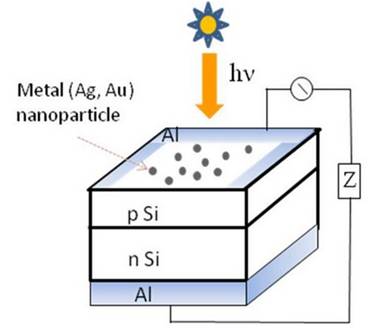In recent years there is an increasing interest in developing new approaches to improve the efficiency of photovoltaic cells (solar cells). Silicon is the most widely used material for solar cells and is due to its abundance in nature, stability, non-toxicity and well established refining and processing technologies [1]. Even though commercial single crystalline silicon solar cells are highly efficient, their high manufacturing costs present an issue from coming forth in the energy markets. On the other hand, thin-film silicon solar cells are cheaper to manufacture, but are less efficient compared with the single crystalline silicon based solar cells [2]. This limitation of thin-film silicon solar cells is due to the low absorption of light caused by the reduction of thickness. Some research groups have been proposed the use of metallic nanoparticles on the surface of thin-films silicon solar cells (called plasmonic solar cells) by means of their strong ability to scatter light.

Figure 1: Scheme of a plasmonic solar cell. www.lumerical.com/…/solar_plasmonic.php A common design of a plasmonic solar cell consists of deposited metal nanoparticles on the top surface of the thin-film silicon solar cell. When these metal nanoparticles are irradiated with light at their surface plasmon resonance, the light is scattered in different directions causing the light to travel along the solar cell and jump between the substrate and the nanoparticles allowing the solar cell to absorb more light. Catchpole et al. at the University of New South Wales showed an improvement of the overall light-gathering efficiency for solar cells using metallic nanoparticles of 30 percent [3]. Nowadays they are investigating the effect of particle size and shape in the performance of the plasmonic solar cells. References [1] S. Pillai, K. R. Catchpole, T. Trupke, and M. A. Green. Surface Plasmon enhanced silicon solar cells. Journal of Applied Physics, 101, 2007. [2] M. A. Green, K. Emery, Y. Hishikawa, and W. Warta. Solar cell efficiency tables (version 31). Progress in Photovoltaics: Research and Applications, 16, 2008. [3] K.R. Catchpole and A. Polman. Plasmonic Solar Cells, Optics Express, 16, 2008.
